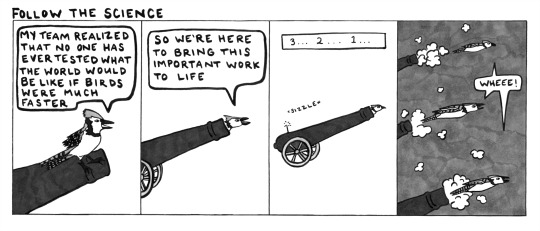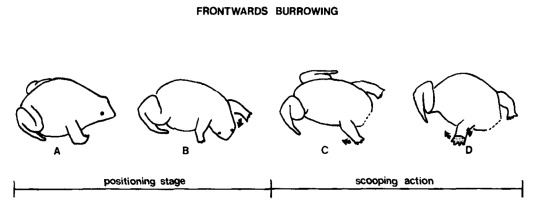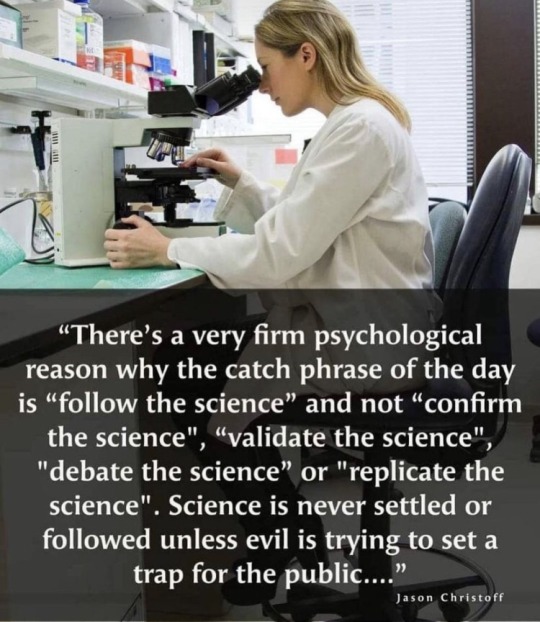#follow the science
Text
If you're going to follow the science... Make sure you follow the right science. 🤔
#pay attention#educate yourselves#educate yourself#knowledge is power#reeducate yourself#reeducate yourselves#think for yourselves#think about it#think for yourself#do your homework#do your own research#do some research#ask yourself questions#question everything#follow the science
911 notes
·
View notes
Text

#abortion#pro life#follow the science#science#catholic#catholicism#christianity#spiritual warfare#jesus christ#blessed virgin mary#our lady
77 notes
·
View notes
Photo

No hypothesis necessary
#science#experiment#follow the science#bird#bluejay#blue jay#cannon#explosive results#comic#cartoons#loveamongthelampreys.com
64 notes
·
View notes
Text
youtube
A 3D animated not yet cancelled short film about not too distant future.
3 notes
·
View notes
Text
"Follow the science."
Everyone who sold heroin-infused snake oil from the back of a wagon in 1889's unincorporated portions of the Gadsden Purchase claimed it was "scientifically proven" to cure both hysteria and syphilis. The FDA was created specifically to stop people from lying like this.
Elon Musk on Twitter in 2022 is exactly as noble and trustworthy as this guy:

5 notes
·
View notes
Text
The Pfizer Shot Is Contaminated With Plasmid DNA, It's Not Just mRNA, It's Got Bits Of DNA In it. 👇
"This DNA is the DNA vector that was used as the template for the invitro transcription reaction when they made the mRNA."
Professor Phillip Buckhaults.
Ph.D. in Biochemistry and Molecular Biology.
He does cancer genomics research at the University of South Carolina. An expert on which changes to the genome cause cancer. His team is really good at detecting foreign pieces of DNA in places where they are not supposed to be. 🤔
#pay attention#educate yourselves#educate yourself#knowledge is power#reeducate yourself#reeducate yourselves#think for yourselves#think about it#think for yourself#do your homework#do your own research#do some research#ask yourself questions#question everything#follow the science#vaccine
549 notes
·
View notes
Text

#pro life#abortion#follow the science#sanctity of human life#human life#right to life#science#live action#medical facts
47 notes
·
View notes
Text
youtube
#unbelievable#robert f kennedy jr#vaccine#Conspiracy#not a conspiracy theorist#follow the science#1 in 36 injuries from covid vaccines#covid#Youtube
0 notes
Text

Clyde William Tombaugh was born on February 4, 1906. He was an American astronomer. He discovered Pluto in 1930, the first object to be discovered in what would later be identified as the Kuiper belt. At the time of discovery, Pluto was considered a planet, but was reclassified as a dwarf planet in 2006. Tombaugh also discovered many asteroids, and called for the serious scientific research of unidentified flying objects.
Tombaugh was born in Streator, Illinois, son of Muron Dealvo Tombaugh, a farmer, and his wife Adella Pearl Chritton. After his family moved to Burdett, Kansas, in 1922, Tombaugh’s plans for attending college were frustrated when a hailstorm ruined his family’s farm crops. Starting in 1926, he built several telescopes with lenses and mirrors by himself. To better test his telescope mirrors, Tombaugh, with just a pick and shovel, dug a pit 24 feet long, 8 feet deep, and 7 feet wide. This provided a constant air temperature, free of air currents, and was also used by the family as a root cellar and emergency shelter. He sent drawings of Jupiter and Mars to the Lowell Observatory, at Flagstaff, Arizona, which offered him a job. Tombaugh worked there from 1929 to 1945.
Following his discovery of Pluto, Tombaugh earned bachelor’s and master’s degrees in astronomy from the University of Kansas in 1936 and 1938. During World War II he taught naval personnel navigation at Northern Arizona University. He worked at White Sands Missile Range in the early 1950s, and taught astronomy at New Mexico State University from 1955 until his retirement in 1973. In 1980 he was inducted into the International Space Hall of Fame.
The asteroid 1604 Tombaugh, discovered in 1931, is named after him. He discovered hundreds of asteroids, beginning with 2839 Annette in 1929, mostly as a by-product of his search for Pluto and his searches for other celestial objects. Tombaugh named some of them after his wife, children and grandchildren. The Royal Astronomical Society awarded him the Jackson-Gwilt Medal in 1931.
Direct visual observation became rare in astronomy. By 1965 Robert S. Richardson called Tombaugh one of two great living experienced visual observers as talented as Percival Lowell or Giovanni Schiaparelli. In 1980, Tombaugh and Patrick Moore wrote a book Out of the Darkness: The Planet Pluto. In August 1992, JPL scientist Robert Staehle called Tombaugh, requesting permission to visit his planet. “I told him he was welcome to it”, Tombaugh later remembered, “though he’s got to go one long, cold trip.“ The call eventually led to the launch of the New Horizons space probe to Pluto in 2006. Following the passage of Pluto by New Horizons on July 14, 2015, the "Heart of Pluto” was named Tombaugh Regio.
Tombaugh continued searching for over a decade after the discovery of Pluto, and the lack of further discoveries left him satisfied that no other object of a comparable apparent magnitude existed near the ecliptic. No more trans-Neptunian objects were discovered until 15760 Albion in 1992.
However, more recently the relatively bright object Makemake has been discovered. It has a relatively high orbital inclination, but at the time of Tombaugh’s discovery of Pluto, Makemake was only a few degrees from the ecliptic near the border of Taurus and Auriga at an apparent magnitude of 16. This position was also very near the galactic equator, making it almost impossible to find such an object within the dense concentration of background stars of the Milky Way. In the fourteen years of looking for planets, until he was drafted in July 1943, Tombaugh looked for motion in 90 million star images (two each of 45 million stars).
Tombaugh was probably the most eminent astronomer to have reported seeing unidentified flying objects. On August 20, 1949, Tombaugh saw several unidentified objects near Las Cruces, New Mexico. He described them as six to eight rectangular lights, stating: “I doubt that the phenomenon was any terrestrial reflection, because… nothing of the kind has ever appeared before or since… I was so unprepared for such a strange sight that I was really petrified with astonishment.”
Tombaugh observed these rectangles of light for about 3 seconds and his wife saw them for about 1 1⁄2 seconds. He never supported the interpretation as a spaceship that has often been attributed to him. He considered other possibilities, with a temperature inversion as the most likely cause.
From my own studies of the solar system I cannot entertain any serious possibility for intelligent life on other planets, not even for Mars… The logistics of visitations from planets revolving around the nearer stars is staggering. In consideration of the hundreds of millions of years in the geologic time scale when such visits may have possibly occurred, the odds of a single visit in a given century or millennium are overwhelmingly against such an event.
A much more likely source of explanation is some natural optical phenomenon in our own atmosphere. In my 1949 sightings the faintness of the object, together with the manner of fading in intensity as it traveled away from the zenith towards the southeastern horizon, is quite suggestive of a reflection from an optical boundary or surface of slight contrast in refractive index, as in an inversion layer.
I have never seen anything like it before or since, and I have spent a lot of time where the night sky could be seen well. This suggests that the phenomenon involves a comparatively rare set of conditions or circumstances to produce it, but nothing like the odds of an interstellar visitation.
Another sighting by Tombaugh a year or two later while at a White Sands observatory was of an object of −6 magnitude, four times brighter than Venus at its brightest, going from the zenith to the southern horizon in about 3 seconds. The object executed the same maneuvers as in Tombaugh’s first sighting.
Tombaugh later reported having seen three of the mysterious green fireballs, which suddenly appeared over New Mexico in late 1948 and continued at least through the early 1950s. A researcher on Project Twinkle reported that Tombaugh “… never observed an unexplainable aerial object despite his continuous and extensive observations of the sky.”
According to an entry in “UFO updates”, Tombaugh said: “I have seen three objects in the last seven years which defied any explanation of known phenomenon, such as Venus, atmospheric optic, meteors or planes. I am a professional, highly skilled, professional astronomer. In addition I have seen three green fireballs which were unusual in behavior from normal green fireballs… I think that several reputable scientists are being unscientific in refusing to entertain the possibility of extraterrestrial origin and nature.”
Shortly after this, in January 1957, in an Associated Press article in the Alamogordo Daily News titled “Celestial Visitors May Be Invading Earth’s Atmosphere”, Tombaugh was again quoted on his sightings and opinion about them. “Although our own solar system is believed to support no other life than on Earth, other stars in the galaxy may have hundreds of thousands of habitable worlds. Races on these worlds may have been able to utilize the tremendous amounts of power required to bridge the space between the stars …”. Tombaugh stated that he had observed celestial phenomena which he could not explain, but had seen none personally since 1951 or 1952. “These things, which do appear to be directed, are unlike any other phenomena I ever observed. Their apparent lack of obedience to the ordinary laws of celestial motion gives credence.”
In 1949, Tombaugh had also told the Naval missile director at White Sands Missile Range, Commander Robert McLaughlin, that he had seen a bright flash on Mars on August 27, 1941, which he now attributed to an atomic blast. Tombaugh also noted that the first atomic bomb tested in New Mexico would have lit up the dark side of the Earth like a neon sign and that Mars was coincidentally quite close at the time, the implication apparently being that the atomic test would have been visible from Mars.
In June 1952, Dr. J. Allen Hynek, an astronomer acting as a scientific consultant to the Air Force’s Project Blue Book UFO study, secretly conducted a survey of fellow astronomers on UFO sightings and attitudes while attending an astronomy convention. Tombaugh and four other astronomers, including Dr. Lincoln LaPaz of the University of New Mexico, told Hynek about their sightings. Tombaugh also told Hynek that his telescopes were at the Air Force’s disposal for taking photos of UFOs, if he was properly alerted.
Tombaugh died on January 17, 1997, in Las Cruces, New Mexico, at the age of 90. He was cremated. A small portion of his ashes was placed aboard the New Horizons spacecraft. The container includes the inscription: “Interred herein are remains of American Clyde W. Tombaugh, discoverer of Pluto and the Solar System’s ‘third zone’. Adelle and Muron’s boy, Patricia’s husband, Annette and Alden’s father, astronomer, teacher, punster, and friend: Clyde W. Tombaugh (1906–1997)”. Tombaugh was survived by his wife, Patricia (1912–2012), and their children, Annette and Alden.
4 notes
·
View notes
Text
Peer-reviewed instructions for coping with a Bad Day™:

[src]
#relatable#meme#science#frog#this is my favourite figure from any paper ever#Sharon Emerson published some highly influential papers about frog anatomy and locomotion#but this figure cannot be outdone#follow for more fresh fremes (frog memes)
12K notes
·
View notes
Text
How Does Scientific Change Work?
“When persistent efforts by the best researchers fail to resolve the anomalies, the community begins to lose confidence in the paradigm and a crisis period ensues in which serious alternatives can now be entertained”
4 notes
·
View notes



